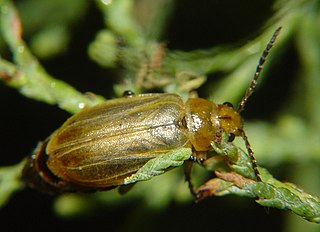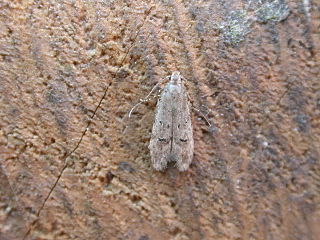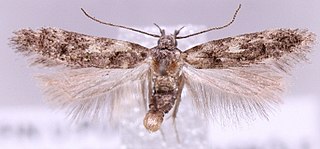
The genus Tamarix is composed of about 50–60 species of flowering plants in the family Tamaricaceae, native to drier areas of Eurasia and Africa. The generic name originated in Latin and may refer to the Tamaris River in Hispania Tarraconensis (Spain).

Teleiodes is a genus of moths in the family Gelechiidae.

Diorhabda elongata is a species of leaf beetle known as the Mediterranean tamarisk beetle (MTB) which feeds on tamarisk trees from Portugal and Algeria east to southern Russia. The MTB is used in North America as a biological pest control agent against saltcedar or tamarisk, an invasive species in arid and semi-arid ecosystems.

Tamarix chinensis is a species of tamarisk known by the common names five-stamen tamarisk and Chinese tamarisk or saltcedar. It is native to China and Korea, and it is known in many other parts of the world as an introduced species and sometimes an invasive noxious weed. It easily inhabits moist habitat with saline soils. It may grow as a tree with a single trunk or as a shrub with several spreading erect branches reaching 6 metres or more in maximum height. It has been known to reach 12 metres. It has reddish, brown, or black bark. The small, multibranched twigs are covered in small lance-shaped, scale-like leaves which are no more than about 3 mm long. The inflorescence is a dense raceme of flowers a few cm long. Each fragrant flower has five petals which are usually pink but range from white to red.

Teleiodes vulgella is a moth of the family Gelechiidae. It is known from most of Europe, east to the southern Ural and the Volga region.

Teleiodes wagae, the hazel groundling, is a moth of the family Gelechiidae. It is found throughout Europe, east to Siberia.

Teleiodes luculella, the crescent groundling, is a moth of the family Gelechiidae. It is found from Europe to the southern Ural and Transcaucasia. The habitat consists of woodlands, including oak woodlands.

Teleiodes flavimaculella, the chestnut groundling, is a moth of the family Gelechiidae. It is widely but locally distributed in Europe, east to Siberia.
Teleiodes pekunensis is a moth of the family Gelechiidae. It is found in South Korea and Japan.
Teleiodes albiluculella is a moth of the family Gelechiidae. It is found on Crete.
Teleiodes brevivalva is a moth of the family Gelechiidae. It is found in northern Italy and Spain.
Teleiodes italica is a moth of the family Gelechiidae. It is found in Switzerland, northern Italy, southern France and Spain.
Teleiodes bradleyi is a moth of the family Gelechiidae. It is found in Korea.
Teleiodes paraluculella is a moth of the family Gelechiidae. It is found in Korea.
Teleiodes cyrtocostella is a moth of the family Gelechiidae. It is found in Korea.
Teleiodes flavipunctatella is a moth of the family Gelechiidae. It is found in Korea.
Teleiodes soyangae is a moth of the family Gelechiidae. It is found in Korea.
Teleiodes linearivalvata is a moth of the family Gelechiidae. It is found in South Korea and Japan.
Teleiodes hortensis is a moth of the family Gelechiidae. It is found in China.
Teleiodes qinghaiensis is a moth of the family Gelechiidae. It is found in China.







